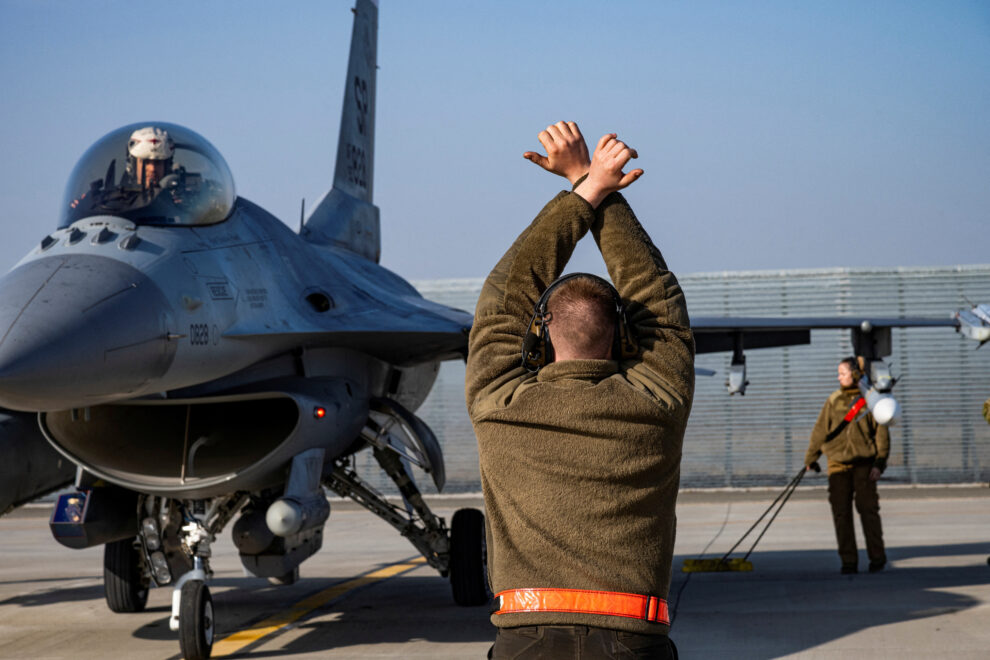The U.S. has begun training Ukrainian pilots to fly F-16s, the U.S. Air Force announced Oct. 25.
A “small number” of Ukrainian pilots began training with the 162nd Wing of the Arizona Air National Guard earlier this week in “F-16 fundamentals,” according to a service spokesperson.
“The training curriculum will align with the foundational knowledge and skills of each pilot and is expected to last several months,” a U.S. Air Force spokesperson said in a statement provided to Air & Space Forces Magazine.
The 162nd Wing trains pilots at Morris Air National Guard Base, which is located at Tucson International Airport. It is the only unit in the U.S. Air Force tasked with training foreign pilots on F-16s as part of its day-to-day mission. The wing has trained over two dozen countries in how to operate the F-16.
“They’re very intimately familiar on how we do training of foreign military pilots,” Lt. Gen. Michael A. Loh, the director of the Air National Guard, said in September.
A typical F-16 training course takes around six months. However, U.S. officials have indicated Ukrainian pilots are unlikely to follow a standard model as the course will be suited to Ukraine’s need to protect its skies from Russian aircraft, drones, and missiles. European nations are also training Ukrainian pilots in how to operate the F-16.
Training of F-16 pilots typically includes significant classroom and simulator time in addition to training in the air. Foreign F-16 pilots also have to undergo English language training, which Ukrainians began last month at Lackland Air Force Base, Texas.
“For Ukraine, it is going to be tailored for exactly what they need to do, which is multirole, both air-to-air and air-to-ground,” Loh said. “We will train them to do the full multirole spectrum of what we can expect in their theory of conflict.”
Ukrainian pilots are not expected to start flying F-16s in combat until 2024. European nations have pledged to provide Ukraine with used F-16s. The U.S. has committed to training some pilots and maintainers to supplement the coalition of countries working to provide Ukraine with F-16s.
Gen. James B. Hecker, commander of U.S. Air Forces in Europe, said in an interview in September that “up to about 10 pilots” would be trained by the U.S. The Pentagon has said the U.S. will also train “dozens” of maintainers, though the U.S. has not revealed whether that training has begun.
“One of the reasons why the F-16 is such a good match for the Ukrainian Air Force is because of the multiple roles that it can conduct,” said retired Lt. Gen. David A. Deptula, a former fighter pilot and dean of the Mitchell Institute for Aerospace Studies. “It can perform air-to-air combat, which is a role that is critical in providing air defense for the cities and military areas that require protection from Russian attack in Ukraine.”
The F-16 can also be used to employ air-to-surface weapons and to suppress enemy air defenses. Such capabilities would enhance Ukraine’s ability to retake its territory by providing capabilities that ground forces alone cannot, Deptula said.
“What the F-16 does allows the Ukrainians to leverage multi-domain operations in a way that they simply don’t have the ability to do today,” he added.
Though the U.S. has not pledged to provide any American-owned F-16s, transferring the stalwart multirole fighter—around 3,000 of which are in service around the world—requires approval by the American government to be given to Ukraine, which the Biden administration signaled it would sign off on in the summer.
The training by the 162nd Wing “follows President Biden and Secretary Austin’s decision to train Ukrainian pilots on F-16s as part of the United States’ contribution to Ukraine,” the Air Force spokesperson said.
Source: Air & Space Forces Magazine















